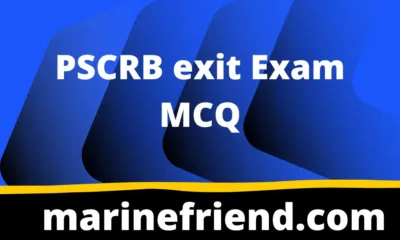FPFF
Fpff exit exam questions and answers part 1

Fpff exit exam questions and answers
30 questions and answers selected which help you to pass Fpff exit exam.
- What is the primary purpose of Fire Prevention and Fire Fighting (FPFF) training?
a. Responding to medical emergencies
b. Controlling and extinguishing fires
c. Conducting rescue operations in water
d. Operating heavy machinery
Answer: b. Controlling and extinguishing fires
- Which of the following is a key component of fire prevention?
a. Ignoring potential hazards
b. Regularly inspecting and maintaining fire safety equipment
c. Smoking in designated areas only
d. Storing flammable materials near heat sources
Answer: b. Regularly inspecting and maintaining fire safety equipment
- In case of a fire emergency, what does the term “PASS” stand for when using a portable fire extinguisher?
a. Pull, Aim, Squeeze, Sweep
b. Push, Assess, Spray, Secure
c. Point, Activate, Stop, Scan
d. Prevent, Announce, Seek, Secure
Answer: a. Pull, Aim, Squeeze, Sweep
- What is the correct procedure for evacuating a building during a fire emergency?
a. Use elevators to exit quickly
b. Stay in your office until instructed otherwise
c. Follow designated escape routes and assembly points
d. Ignore alarms unless you see flames
Answer: c. Follow designated escape routes and assembly points
- Which class of fire involves flammable liquids and gases?
a. Class A
b. Class B
c. Class C
d. Class D
Answer: b. Class B
- What is the purpose of a fire safety drill?
a. To test the building’s air conditioning
b. To practice emergency response procedures
c. To check the availability of snacks in break rooms
d. To inspect the cleanliness of the workplace
Answer: b. To practice emergency response procedures
- How should you respond if your clothing catches fire?
a. Run quickly to the nearest exit
b. Stop, drop to the ground, cover your face, and roll
c. Spray water directly on the flames
d. Call for help and wait for assistance
Answer: b. Stop, drop to the ground, cover your face, and roll
- Which of the following is a common cause of electrical fires?
a. Regular equipment maintenance
b. Overloaded electrical outlets
c. Using appliances as intended
d. Turning off electrical devices when not in use
Answer: b. Overloaded electrical outlets
- What type of fire extinguisher is suitable for electrical fires?
a. Water extinguisher
b. Foam extinguisher
c. CO2 extinguisher
d. Dry powder extinguisher
Answer: c. CO2 extinguisher

- What should you do if you discover a small, contained fire?
a. Attempt to extinguish it using the appropriate fire extinguisher
b. Ignore it and assume someone else will handle it
c. Evacuate the area immediately
d. Document the fire for later investigation
Answer: a. Attempt to extinguish it using the appropriate fire extinguisher
- What is the purpose of a fire blanket?
a. To warm individuals during cold weather
b. To cover furniture and prevent fire damage
c. To smother and extinguish small fires on a person’s clothing
d. To provide a cushion for emergency landings
Answer: c. To smother and extinguish small fires on a person’s clothing
- Which of the following is a common source of ignition in the workplace?
a. Adequately maintained electrical equipment
b. Regularly tested fire alarms
c. Employees wearing proper protective gear
d. Poorly stored flammable materials
Answer: d. Poorly stored flammable materials
- In the event of a fire, what is the first step in the emergency response plan?
a. Evacuate the building immediately
b. Call emergency services (fire department)
c. Activate the fire alarm
d. Attempt to extinguish the fire
Answer: c. Activate the fire alarm
- What is the recommended method for checking if a door is safe to open during a fire?
a. Use the back of your hand to feel for heat
b. Open the door quickly and assess the situation
c. Smell for smoke under the door
d. Knock on the door to check for a response
Answer: a. Use the back of your hand to feel for heat
- Which of the following fire types involves combustible metals?
a. Class A
b. Class B
c. Class C
d. Class D
Answer: d. Class D
- What does the acronym “RACE” stand for in the context of fire safety?
a. Rescue, Assess, Contain, Evacuate
b. Run, Alert, Cover, Escape
c. Remove, Activate, Control, Extinguish
d. Rescue, Alarm, Confine, Extinguish
Answer: d. Rescue, Alarm, Confine, Extinguish
- How often should fire extinguishers be inspected?
a. Monthly
b. Annually
c. Every three years
d. Only when visibly damaged
Answer: a. Monthly
- What is the purpose of a fire drill?
a. To test the building’s heating system
b. To evaluate employee performance during an emergency
c. To practice fire prevention techniques at the workplace
d. To assess the quality of fire extinguishers
Answer: b. To evaluate employee performance during an emergency
- When using a fire extinguisher, what is the recommended distance from the fire?
a. Stand at a safe distance of 20 feet
b. Stand as close as possible for accuracy
c. Stand at a distance of 6 feet
d. It depends on the type of fire extinguisher
Answer: d. It depends on the type of fire extinguisher
- What should you do if you are unable to extinguish a fire using a fire extinguisher?
a. Keep trying until the fire is out
b. Call emergency services and evacuate the area
c. Wait for someone else to handle it
d. Use water to supplement the extinguisher
Answer: b. Call emergency services and evacuate the area
- Which of the following is a common cause of kitchen fires?
a. Regular cleaning and maintenance of cooking appliances
b. Leaving cooking unattended
c. Storing flammable materials away from the kitchen
d. Using the oven for additional storage
Answer: b. Leaving cooking unattended
- What is the purpose of a fire safety audit?
a. To identify potential fire hazards and improve safety measures
b. To assess employee productivity
c. To evaluate the efficiency of the heating system
d. To determine the cost of fire prevention measures
Answer: a. To identify potential fire hazards and improve safety measures
- What type of fire involves ordinary combustible materials such as wood, paper, and cloth?
a. Class A
b. Class B
c. Class C
d. Class D
Answer: a. Class A
- Why is it important to have clear evacuation routes posted in the workplace?
a. To enhance the office decor
b. To guide employees during routine breaks
c. To assist in the safe evacuation of the building during emergencies
d. To provide directions to the nearest coffee shop
Answer: c. To assist in the safe evacuation of the building during emergencies
- What is the purpose of fire doors in a building?
a. To control the spread of fire and smoke
b. To provide a decorative element to the architecture
c. To serve as emergency exits only
d. To keep the building warm in winter
Answer: a. To control the spread of fire and smoke
- What is the correct method for using a fire hose?
a. Aim the hose at the base of the flames and sweep from side to side
b. Hold the hose above the flames to smother them
c. Direct the water stream towards the ceiling
d. Keep the hose coiled until the fire is larger
Answer: a. Aim the hose at the base of the flames and sweep from side to side
- What is the purpose of a fire safety coordinator in a workplace?
a. To organize company picnics
b. To lead emergency response teams during fire incidents
c. To manage the office budget
d. To provide first aid during emergencies
Answer: b. To lead emergency response teams during fire incidents
- Why is it important to keep electrical cords in good condition?
a. To reduce clutter in the workspace
b. To make it easier to plug and unplug devices
c. To prevent electrical fires and shocks
d. To save on electricity costs
Answer: c. To prevent electrical fires and shocks
- What should you do if you encounter a closed door during a fire evacuation?
a. Assume it is locked and find an alternative route
b. Open it quickly and proceed
c. Use the door handle to check for heat, and if cool, proceed with caution
d. Wait for someone else to open it
Answer:c. Use the door handle to check for heat, and if cool, proceed with caution
- What is the purpose of fire safety signage in the workplace?
a. To advertise fire prevention products
b. To serve as decoration in hallways
c. To provide clear instructions and information about fire safety measures
d. To direct employees to the nearest restroom
Answer: c. To provide clear instructions and information about fire safety measures
Fpff exit exam questions and answers part 1
Fpff exit exam questions and answers part 2
Fpff exit exam questions and answers part 3
Also read:
OCTCO exit exam questions and answers
MFA Exit exam questions and answers
PST Exit exam questions and answers
These questions are generated from the e-learning website of DG shipping.

-

 SEAFARERS4 years ago
SEAFARERS4 years agoBsid dg shipping email id and contacts
-

 SEAFARERS4 years ago
SEAFARERS4 years agocommerce se merchant navy kar sakta hai kya?
-

 RPSL4 years ago
RPSL4 years agoBlacklisted RPSL companies 2021/2022/PART-2
-

 COLLEGES4 years ago
COLLEGES4 years agoGp rating college list approved by dg shipping in india
-

 RPSL4 years ago
RPSL4 years agoBlacklisted RPSL companies 2021/2022/PART-1
-

 RPSL4 years ago
RPSL4 years agodg shipping approved company
-

 RPSL4 years ago
RPSL4 years agorpsl shipping company list in Belapur
-

 PSCRB2 years ago
PSCRB2 years agoPSCRB exit Exam MCQ-1











